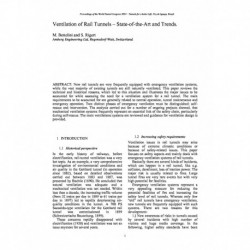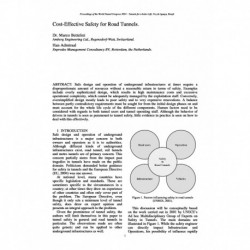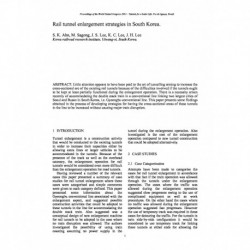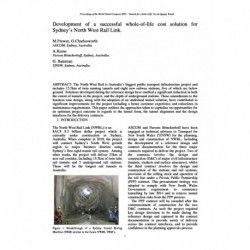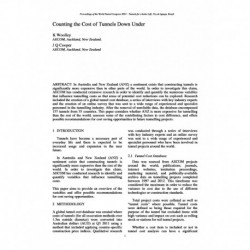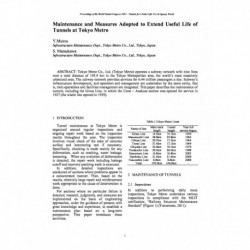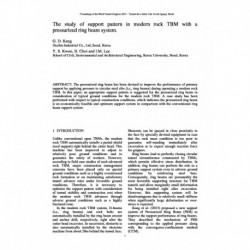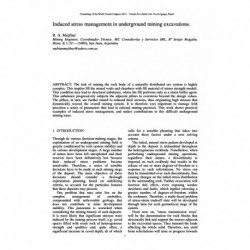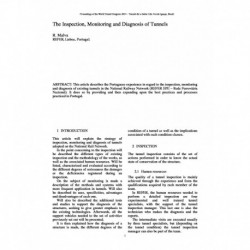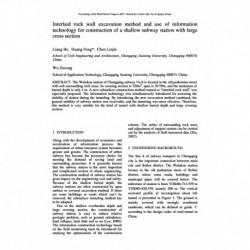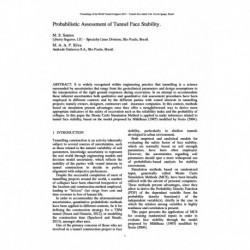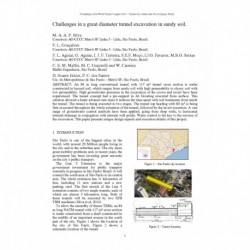No document
Search & filter
Search for a publication
Search & filter
World Tunnelling Congress
WTCThere are 1984 documents.
-
Ventilation of Rail Tunnels – State-of-the-Art and Trends
Abstract: New rail tunnels are very frequently equipped with emergency ventilation systems, while the vast majority of existing tunnels are still naturally ventilated. This paper reviews the technical and historical reasons, which led to this situation and illustrates the major issues to be accounted for while assessing the need for a ventilation system for a rail tunnel. The main requirements to be...
0,00 € -
Cost-Effective Safety for Road Tunnels
Abstract: Safe design and operation of underground infrastructures at times require a disproportionate amount of resources without a reasonable return in terms of safety. Examples include overly sophisticated design, which results in high maintenance costs and excessive operational complexity, which cannot be adequately managed by the exploitation staff. Conversely, oversimplified design mostly leads to...
0,00 € -
Rail tunnel enlargement strategies in South Korea
Abstract: Little attention appears to have been paid to the art of tunnelling aiming to increase the cross-sectional are of the existing rail tunnels because of the difficulties involved if the tunnels ought to be kept at least partially functional during the enlargement operation. There is a necessity arisen recently of accommodating the double stack train in a conventional line linking two largest...
0,00 € -
Development of a successful whole-of-life cost solution for Sydney’s North West Rail Link
Abstract: The North West Rail is Australia’s biggest public transport infrastructure project and includes 15.5km of twin running tunnels and eight new railway stations, five of which are below ground. Solutions developed during the reference design have enabled a significant reduction in both the extent of tunnels in the project, and the depth of underground stations. These amendments to the business...
0,00 € -
Counting the Cost of Tunnels Down Under
Abstract: In Australia and New Zealand (ANZ) a sentiment exists that constructing tunnels is significantly more expensive than in other parts of the world. In order to investigate this claim, AECOM has conducted extensive research in order to identify and quantify the numerous variables that influence tunnelling costs so that areas of potential cost reductions can be explored. Research included the...
0,00 € -
Maintenance and Measures Adopted to Extend Useful Life of Tunnels at Tokyo Metro
Abstract: Tokyo Metro Co., Ltd. (Tokyo Metro) operates a subway network with nine lines over a total distance of 195.9 km in the Tokyo Metropolitan area, the world’s most massively urbanized area. The subway network provides services for 6.44 million passengers a day. Subway’s infrastructure development, and operation and management are undertaken by the same entity, that is, train...
0,00 € -
The study of support pattern in modern rock TBM with a pressurized ring beam system
Abstract: The pressurized ring beam has been devised to improve the performance of primary support by applying pressure to circular steel ribs (i.e., ring beams) during operating a modern rock TBM. In this paper, an appropriate support pattern is suggested for the pressurized ring beam in consideration of typical ground conditions for the modern rock TBM. A case study has been performed with respect to...
0,00 € -
Conveyance and Storage Tunnel in Hartford, Connecticut
Abstract: The South Hartford Conveyance and Storage Tunnel (SHCST) is a major component of the Hartford Metropolitan District’s Clean Water Project (CWP). This tunnel is intended to capture and store Combined Sewer Overflows (CSO) from the southern portion of Hartford, CT and Sanitary Sewer Overflows (SSO) from West Hartford and Newington, CT. The project is estimated to cost approximately $500 MM and...
0,00 € -
Damage cause and renovation of base structure of a railway tunnel at slightly-dipping interbedding rocks: a case study
Abstract: The Y.D. Tunnel, designed with double block ballastless tracks in Southwest China was excavated at low-medium thick slightly-dipping interbedding rock mass of medium-weathered mudstone and sandstone. A high uplift appeared in the tunnel floor within the region of K208+620~+629 after the tunnel was put into service, seriously influencing the railway operation. In-situ stress was measured;...
0,00 € -
Induced stress management in underground mining excavations
Abstract: The task of mining the rock body of a naturally distributed ore system is highly complex. This implies fill the mined voids and chambers with fill material of minor strength moduli. This condition may lead to structural unbalance, where the fill performs only as a strain buffer agent. This unbalance progressively subjects the adjacent pillars to overstress beyond the design values. The pillars,...
0,00 € -
Design and Construction of Underground Caverns under Different Geological Conditions in the Andean Region
Abstract: This article presents design criteria, behavioral and construction aspects of five deep underground power stations excavated in sedimentary, igneous and metamorphic rocks, as components of an equal number of hydropower projects either in operation or construction in the Andes Mountain Range. Guavio is highlighted amongst several cases as one of the deepest power stations in...
0,00 € -
Geological and Geotechnical Aspects of Line 4S RJ - Stretch Morro do Cantagalo-Gávea
Abstract: The present paper introduces the main geological and geotechnical aspects of Line 4: Stretch South from Rio de Janeiro Metro system. Crossing several geological scenarios, from very good rock to soils formed in transitional environment, the stretch will be excavated with Tunneling Boring Machine (TBM) with a diameter greater than 10 meters. Having as main reference more than 250 boreholes, the...
0,00 € -
The Inspection, Monitoring and Diagnosis of Tunnels
Abstract: This article describes the Portuguese experience in regard to the inspection, monitoring and diagnosis of existing tunnels in the National Railway Network (REFER EPE – Rede Ferroviária Nacional). It does so by providing and then expanding upon the best practices and processes practiced in Portugal.
0,00 € -
Interlaid rock wall excavation method and use of information technology for construction of a shallow subway station...
Abstract: The Wulukou station of Chongqing subway No.6 is located in the old pedestrian streetwith soft surrounding rock mass. Its crossing section is 326m, span is 20.59m, and the minimum of buried depth is only 4 m. A new subsurface construction method named as “interlaid rock wall” was especially proposed. The information technology was simultaneously introduced for assessing the stability of station...
0,00 € -
Probabilistic Assessment of Tunnel Face Stability
Abstract: It is widely recognised within engineering practice that tunnelling is a science surrounded by uncertainties that range from the geotechnical parameters and design assumptions to the interpretation of the right ground responses during excavation. In an attempt to accommodate these inherent uncertainties both qualitative and quantitative risk assessment procedures have been employed in different...
0,00 € -
Challenges in a great diameter tunnel excavation in sandy soil
Abstract: An 84 m long conventional tunnel with 117 m² tunnel cross section is under constructed in layered soil, which ranges from sandy soil with high permeability to clayey soil with low permeability. High groundwater pressures in the excavation of the crown and invert have been experienced. The tunnel concept had a pre-support in Jet Grouting executed from surface. This solution allowed a faster...
0,00 €

